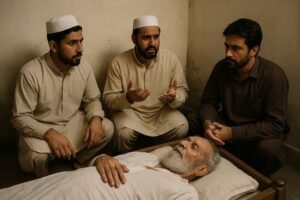In a grand city long ago, there lived a dignitary — a wealthy and respected ruler — who had a daughter of exquisite beauty and high station. She was not only admired for her elegance and poise but also for her principle: she would never allow any physician to touch her body.
One day, while riding her horse across rugged terrain, the princess lost control and fell. The fall was terrible: her hip joint was dislocated, the bone torn from its socket. Pain wracked her, and from that moment she was crippled — unable to walk, growing weaker by the day.
Her father, heartbroken, summoned every physician in the region. Each one came, looked, and requested to examine her physically. But the princess, rigid with shame or fear, refused to let any of them touch her body — no hand could lay upon her hip, no attempt could be made.

The father tried persuasion. He reminded her: “Even under the laws of our faith, a physician can become a mahram in cases of dire necessity.” But she would not relent. Days turned into weeks; her health declined fast, her strength drained.
Finally, after exhausting all conventional healers, the father was advised to seek out a master physician, a sage rumored to have knowledge beyond the usual, who lived in a remote area beyond the city. With hope rekindled, he traveled to the healer’s secluded dwelling and shared his lamentable tale.
The master physician listened carefully. Then he said, “I can restore your daughter’s hip without ever touching her directly — but there is one condition.”
“Name it,” said the father, desperate.
The physician requested a fine, healthy cow — strong, large, full-bodied, recently fed, in perfect condition — to be delivered to him. The father, though puzzled and anxious, agreed, and procured the best cow in the city at great cost, and brought it to the physician’s home.
The physician then told the father: “Bring your daughter here the day after tomorrow. On that day, by God’s grace, I shall perform the cure.”
When the day arrived, the daughter was carried in on a litter, too weak to walk. The physician instructed the father to seat her gently across the broad back of the cow, positioning her hip carefully. Everyone was amazed: she protested at first, but obeyed, for no one dared defy him.
Next, the physician had the cow’s legs bound around her body with soft ropes, though loosely yet firmly so she could feel the binding. Then he commanded that fodder — the cow’s favorite grass — be placed before her, along with water laced with salt. The cow, having fasted for two days, saw the food and water and ate voraciously, drank deeply.
As the cow’s belly began to swell, as it rumbled with fullness and hydration, its body pressed subtly yet firmly against the princess’s hip — since her leg was bound to its belly. The pressure, the shaping, the positioning — and the princess, in excruciating pain, let out a scream, then lost consciousness. In that moment, with God’s will, her hip bone slipped, with a faint crack, back into its proper place.
When she awoke, she found her father by her side, the physician smiling serenely. Her hip was whole. She could move her leg. Her limp vanished. She cried tears of gratitude.
The physician then declared: “This cow, having served its purpose, is now mine.”
Thus was the princess healed — not by touch, but by ingenuity, by understanding of bodily mechanics and leverage, and perhaps by faith. And many later told that the healer was none other than Avicenna (Ibn Sina), whose name would come to be known across many lands as a master of medicine and mind.
Is This Story True?
I researched historic sources and could not find a credible record or widely accepted historical account confirming this exact story — the version with a princess, a dislocated hip, and the use of a cow in this way.
Here’s what I found:
-
There are several anecdotes about Avicenna (Ibn Sina) treating difficult or unusual medical or psychological cases using clever, non-standard methods or psychological tricks. One story is of a prince who believed he was a cow (a psychiatric delusion); Avicenna cured him by treating him gently, giving him food, and then using a ruse to get him to eat and believe he was improving.
-
That case, however, had to do with a delusion (mental illness), not a physical injury like a dislocated bone or hip.
-
Serious scholarly works (biographies, his medical compendium, The Canon of Medicine, The Book of Healing) do not mention anything that matches the exact details of this story.
So in short: this appears to be a folk legend or parable inspired by stories of Avicenna’s wisdom and miraculous cures, rather than a documented historical fact.







